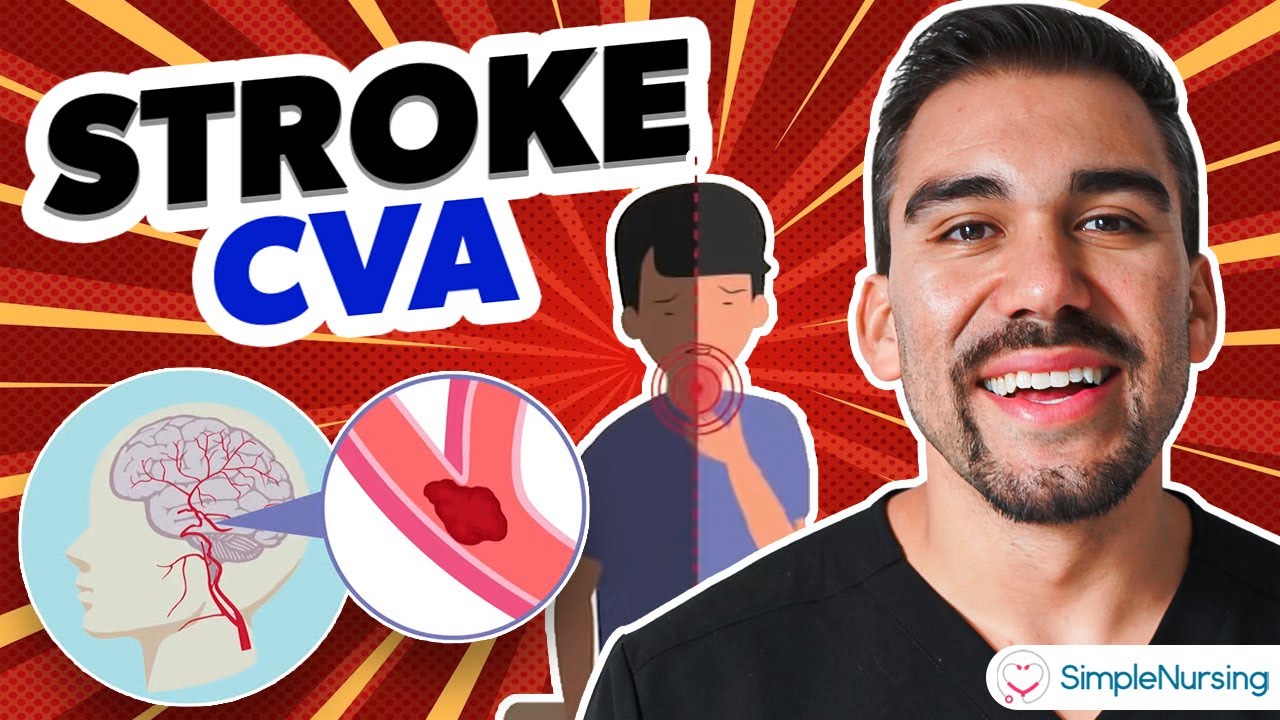Overview of Ischemic and Hemorrhagic Stroke | Clinical Neurology
Summary
TLDRThis video script covers a comprehensive overview of ischemic and hemorrhagic strokes, focusing on their causes, diagnostic workup, and treatment approaches. For ischemic strokes, common causes include thromboembolism, atherosclerosis, lacunar infarcts, watershed ischemia, and cardioembolic strokes, with diagnostic tools such as carotid ultrasounds and EKGs. Treatment involves primary and secondary prevention with antiplatelets and anticoagulants. Hemorrhagic strokes are primarily caused by hypertension, brain tumors, vascular malformations, and amyloid angiopathy. Diagnostic approaches focus on CT scans and managing blood pressure, while treatment involves stopping anticoagulants and controlling seizures. Rehabilitation plays a critical role in recovery for both stroke types.
Takeaways
- 😀 Ischemic stroke has five major causes: thromboembolism, intracranial atherosclerosis, lacunar infarcts, watershed ischemia, and cardioembolic events.
- 😀 Embolic strokes are caused by blood clots from the heart or carotid arteries, leading to large territory strokes with larger symptoms and imaging findings.
- 😀 Atherosclerotic disease, or plaque buildup in blood vessels, leads to moderate territory strokes and is a common stroke risk factor.
- 😀 Lacunar strokes are small vessel strokes caused by small blood vessels in subcortical gray or white matter, often associated with long-standing hypertension.
- 😀 Watershed strokes occur due to reduced blood flow at collateral territories between major blood vessels, not caused by a clot.
- 😀 Diagnostic workup for ischemic stroke includes carotid ultrasounds, transcranial Doppler, transthoracic echocardiography, blood tests (e.g., thyroid study, hemoglobin A1c), and EKGs for atrial fibrillation.
- 😀 Preventing further strokes involves primary and secondary prevention, including antiplatelet agents like aspirin, Plavix, and anticoagulants like Coumadin and Lovenox.
- 😀 Hemorrhagic stroke has five key causes: hypertensive hemorrhage, hemorrhagic transformation of ischemic stroke, brain tumors, vascular malformations (e.g., AVMs, aneurysms), and amyloid angiopathy.
- 😀 Hemorrhagic stroke can be categorized into intracerebral (intracerebral hemorrhage) and subarachnoid hemorrhage, with aneurysms being the primary cause of subarachnoid hemorrhage.
- 😀 Diagnostic approach for hemorrhagic stroke includes a non-contrast head CT to monitor bleeding, MRI to detect tumors, and vascular imaging for lesions, along with blood pressure management to prevent further hemorrhage.
Q & A
What are the five major causes of ischemic stroke?
-The five major causes of ischemic stroke are thromboembolism, intracranial atherosclerosis, lacunar infarcts, watershed ischemia, and embolism or cardioembolic strokes.
How do embolic strokes typically present on imaging?
-Embolic strokes, such as cardioembolic and thromboembolic strokes, tend to result in larger clots that lodge in larger blood vessels, leading to larger territory strokes on imaging. This suggests an embolic phenomenon.
What role does atherosclerosis play in ischemic stroke?
-Atherosclerosis involves the hardening of arteries due to plaque buildup, which can cause strokes of varying sizes, often moderate in territory, typically seen in the anterior or posterior circulation of the brain.
What is a lacunar stroke and what causes it?
-A lacunar stroke is a small vessel stroke that occurs in the deep brain, often in subcortical gray matter or white matter tracks. It is commonly caused by long-standing hypertension affecting small blood vessels, known as perforators.
What is watershed ischemia and how does it occur?
-Watershed ischemia occurs in areas of the brain where blood supply is reduced due to insufficient collateral flow between major vessels, rather than from a blood clot. It affects the areas between these major vessels and is caused by reduced blood flow.
What is the role of carotid ultrasound in diagnosing ischemic stroke?
-Carotid ultrasound is used to assess blood flow in the carotid arteries leading to the brain, helping identify blockages or stenosis that may contribute to ischemic strokes.
What are the main treatment options for ischemic stroke?
-Main treatment options for ischemic stroke include antiplatelet agents like aspirin and Plavix, and anticoagulants like Coumadin or Lovenox. Rehabilitation therapies (physical, occupational, and speech therapy) are also crucial for recovery.
What are the five causes of hemorrhagic stroke?
-The five major causes of hemorrhagic stroke are hypertensive hemorrhage, hemorrhagic transformation of ischemic stroke, brain tumors (including metastases and gliomas), vascular malformations (such as aneurysms and arteriovenous malformations), and amyloid angiopathy.
How does hypertensive hemorrhage lead to a hemorrhagic stroke?
-Hypertensive hemorrhage occurs when high blood pressure weakens the walls of blood vessels, leading to rupture and bleeding into the brain, which causes a hemorrhagic stroke.
What is the key difference in the diagnostic approach between ischemic and hemorrhagic strokes?
-For ischemic strokes, the focus is on identifying the cause of the blood clot, while for hemorrhagic strokes, the focus is on preventing the expansion of bleeding, often through non-contrast head CT, MRI, and vascular imaging.
Outlines

This section is available to paid users only. Please upgrade to access this part.
Upgrade NowMindmap

This section is available to paid users only. Please upgrade to access this part.
Upgrade NowKeywords

This section is available to paid users only. Please upgrade to access this part.
Upgrade NowHighlights

This section is available to paid users only. Please upgrade to access this part.
Upgrade NowTranscripts

This section is available to paid users only. Please upgrade to access this part.
Upgrade NowBrowse More Related Video

STROKE Lengkap - Klasifikasi, Patofisiologi, Skor Siriraj, Gajah Mada, Latihan Soal UKMPPD

Stroke CVA (Cerebrovascular Accident) Hemorrhagic, Ischemic NCLEX RN & LPN NURSING

Brain Stroke, Types of, Causes, Pathology, Symptoms, Treatment and Prevention, Animation.

Ischemic Stroke - causes, symptoms, diagnosis, treatment, pathology

Ischemic Stroke | Lisa Klein

Hemorrhagic stroke: intracerebral hemorrhage - causes, symptoms, diagnosis, treatment, pathology
5.0 / 5 (0 votes)